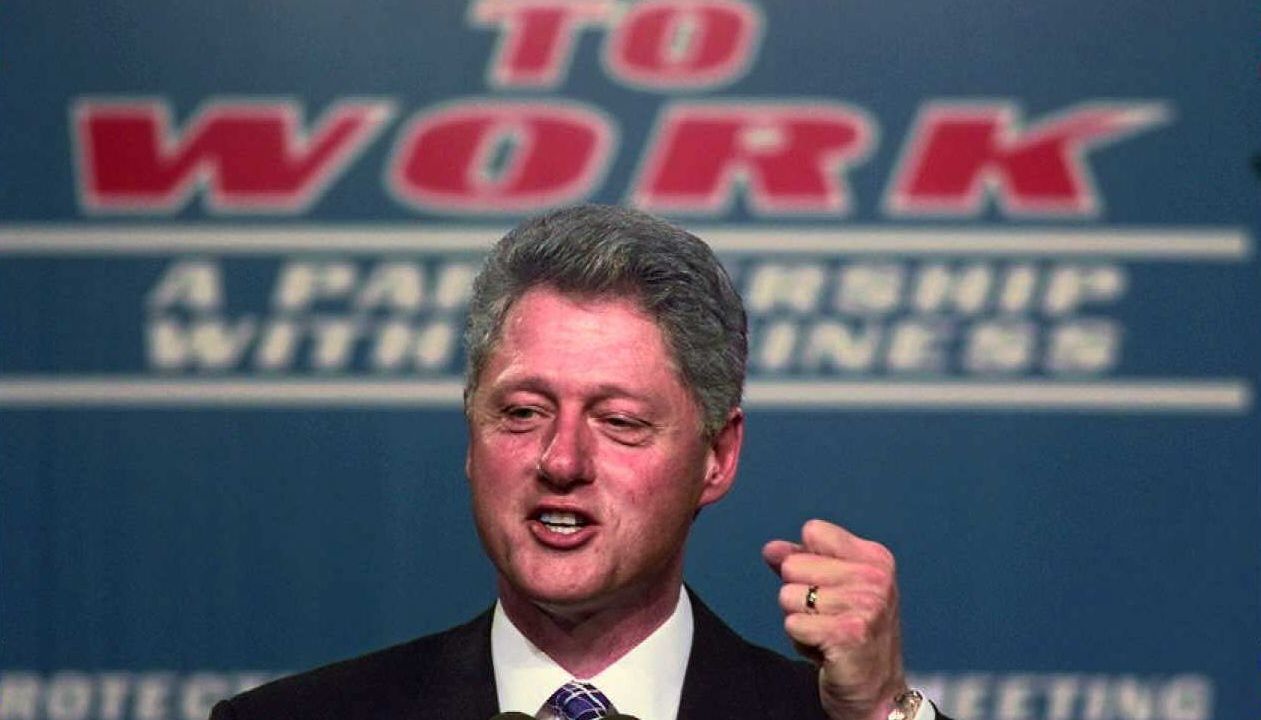
President Bill Clinton during a 1996 speech on welfare reform at Vanderbilt University Medical Center in Nashville, Tennessee. (PAUL J. RICHARDS/AFP/Getty Images)
This post originally appeared at TalkPoverty.
Table of Contents
What’s TANF
What’s a Block Grant?
Isn’t State and Local Control More Effective?
Does It at Least Help People Prepare for Work?
Why Does All This Matter?
So Where Do We Go From Here?
What’s TANF
In 1996, Congress replaced the New Deal-era Aid to Families with Dependent Children (AFDC) with a new program called Temporary Assistance for Needy Families (TANF), under the guise of “ending welfare as we know it.”
The new law built on decades of anti-welfare sentiment, which Ronald Reagan popularized in 1976 with the racially loaded myth of the “welfare queen.” In the two decades that followed, progressives and conservatives alike put forward reform proposals aimed at boosting work and reducing welfare receipt. Progressive proposals included expanded childcare assistance, paid leave and tax credits for working families. Conservatives, on the other hand, tended to favor punitive work requirements — without any of the corresponding investments to address barriers to employment.
In 1996, after vetoing two Republican proposals that drastically cut the program’s funding, President Bill Clinton signed the Personal Responsibility and Work Opportunity Act into law. The new legislation converted AFDC into a flat-funded block grant — TANF — and sent it to the states to administer.
The law’s stated purpose was to move families from “welfare to work.” By that measure, supporters initially heralded TANF as a success during the strong, full-employment economy of the late 1990s. But too often, the narrative stops there, ignoring significant failings in the program that surfaced after the economy slowed down.
What is a Block Grant?
A block grant is essentially a pot of money the federal government gives to state governments to administer a program subject to federal guidelines.
One of the key limitations of block grants is that they can lose value over time. The TANF block grant, for example, has been flat-funded at $16.5 billion since the law was first implemented 20 years ago. In other words, despite the rising cost of living, TANF’s funding hasn’t increased at all. As a result, it has lost more than one-third of its value since 1996, leaving fewer low-income families able to access the help they need. Fewer than one in four families with children living below the federal poverty line are helped by TANF today — down from more than two-thirds in 1996.
Another major limitation is that block grants are unable to respond to economic downturns. During the Great Recession, the number of families helped by TANF barely budged — the number of unemployed workers spiked by nearly 90 percent, but families able to access TANF only ticked up by 16 percent. TANF’s failure to respond to rising economic hardship not only hurts struggling families; it takes away a critical tool to lessen the impact of recessions.
Isn’t state and local control more effective?
Not in TANF’s case. There’s very little accountability with regard to how states must spend this money, so many states treat the program like a slush fund by diverting the funds to a range of other purposes — including closing budget gaps.
As a result, just one out of every four TANF dollars goes to income assistance for poor families with kids — policymakers, the public and the media lack even the most basic information on where the rest of the funds go. By comparison, over 95 percent of Supplemental Nutrition Assistance Program (SNAP, formerly known as food stamps) dollars go to helping struggling families purchase food.
Does it at least help people prepare for work?
Not well. Preparing people for work was one of the stated goals of the 1996 welfare law, but only 8 percent of TANF’s funding goes to employment preparation services. What’s worse, states aren’t actually required to track whether TANF recipients get jobs — employment isn’t even an outcome that gets measured (nor is poverty reduction, for that matter).
Conservatives claim the law gives states flexibility, but states face stiff constraints when it comes to helping participants prepare for and find work. For example, states aren’t allowed to provide “job search and job readiness assistance” for more than four consecutive weeks and six weeks in the entire year — no matter how hard someone is looking for work. In addition, vocational training only counts toward required work activity for 12 months. It’s no wonder that governors from both parties have requested greater flexibility in designing work programs for TANF.
Why does all this matter?
Great question. TANF’s shortcomings don’t just matter to the millions of poor families with kids who aren’t getting the help they need through the program. A full 70 percent of Americans will need to turn to the safety net at some point — whether it’s TANF, nutrition assistance, Supplemental Security Income or Unemployment Insurance. Without these programs, our nation’s poverty rate would be nearly twice as high as it is today.
But despite TANF’s dismal record, many congressional Republicans want to model effective antipoverty tools, including nutrition assistance and housing aid, after TANF — by converting them to block grants.
In total, Speaker Ryan has called for ending 11 anti-poverty programs — including housing assistance, food assistance and child care — and combining them into a single block grant. Just like TANF, the funding would be fixed — making it woefully unresponsive to recessions or changes in the unemployment rate.
So where do we go from here?
To begin with, the federal government should require states to spend a certain share of TANF funds on the law’s core purposes — income assistance, child care and work programs. Requiring states to spend even half of TANF funds on these priorities would ensure that more families get the help they need. We should also hold states accountable for meaningful outcomes such as actually helping TANF recipients get jobs, and reducing poverty.
In addition, Congress should stop rewarding states for ending aid to families in need. Right now, states receive a so-called “caseload reduction credit” for reducing the number of people they help — regardless of whether they have jobs when they leave the program. In effect, instead of giving states incentives to provide needed assistance, we’re doing the opposite.
We also need to increase benefits so that families can meet their basic needs. In no state are benefits equal to even half the austere federal poverty level (the maximum benefit was about $10,000 per year for a family of three in 2015).
Strengthening TANF is critical to ensure that our nation’s safety net provides adequate protection against life’s unpredictability. But it is just one part of a broader anti-poverty agenda.
Building an economy that works for everyone — not just the wealthy few — will require creating good jobs and ensuring a living wage; adopting work-family policies that ensure parents are not forced to choose between work and caregiving; putting child care and high-quality education within reach for all families; and removing barriers to opportunity so that all families have the opportunity to succeed.





